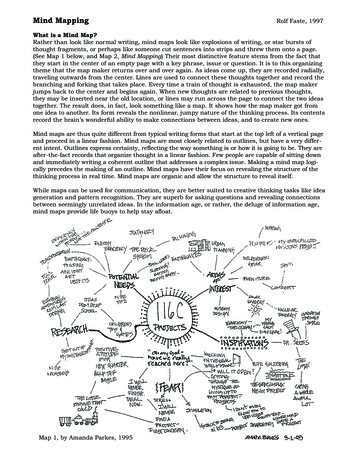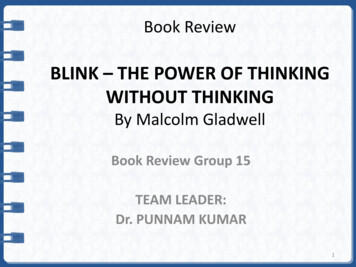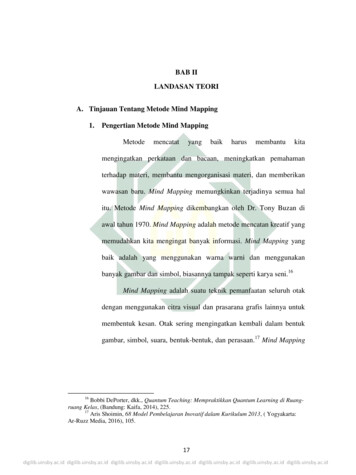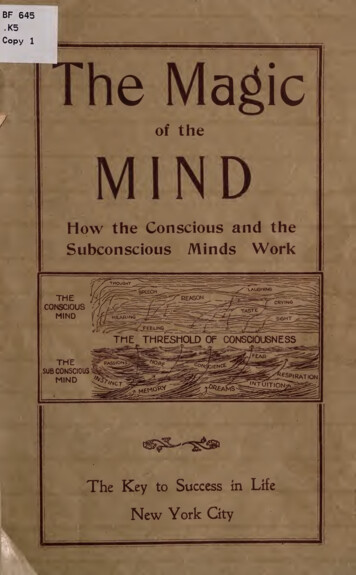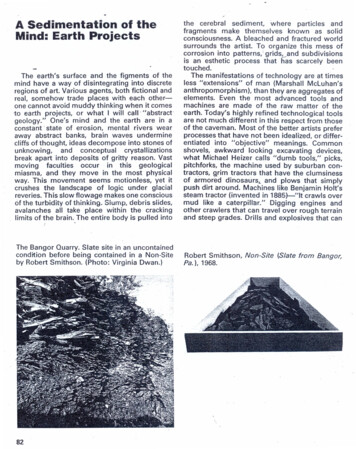
Transcription
A Sedimentation of theMind: Earth ProjectsThe earth's surface and the figments of themind have a way of disintegrating into discreteregions of art. Various agents, both fictional andreal, somehow trade places with each otherone cannot avoid muddy thinking when it comesto earth projects, or what I will call" "abstractgeology." One's mind and the earth are in aconstant· state of erosion, mental rivers wearaway abstract banks, brain waves underminecliffs of thought, ideas decompose into stones ofunknowing,and conceptual crystallizationsbreak apart into deposits of gritty reason. Vastmoving faculties occur in this geologicalmiasma, and they move in the most physicalway. This movement seems motionless, yet itcrushes the landscape of logic under glacialreveries. This slow flowage makes one consciousof the turbidity of thinking. Slump, debris slides,avalanches all take place within the crackinglimits of the brain. The entire body is pulled into.'.The Bangor Quarry. Slate site in an uncontainedcondition before being contained in a Non-Siteby Robert Smithson. (Photo: Virginia Dwan.)the cerebral sediment, where particles andfragments make themselves known as solidconsciousness. A bleached and fractured worldsurrounds the artist. To organize this mess ofcorrosion into patterns,; grids, and subdivisionsis an esthetic process that has scarcely beentouched.The manifestations of technology are at timesless "extensions" of man (Marshall McLuhan'santhropomorphism), than they are aggregates ofelements. Even the most advanced tools andmachines are made of the raw matter of theearth. Today's highly refined technological toolsare not much different in this respect from thoseof the caveman. Most of the better artists preferprocesses that have not been idealized, or differentiated into "objective" meanings. Commonshovels, awkward looking excavating devices,what Michael Heizer calls "dumb tools," picks,pitchforks, the machine used by suburban contractors, grim tractors that have the clumsinessof armored dinosaurs . and plows that simplypush dirt around. Machines like Benjamin Holt'ssteam tractor (invented in 1885)--"lt crawls overmud like a caterpillar." Digging engines andother crawlers that can travel over rough terrainand steep grades. Drills and explosives that canRobert Smithson, Non-Site (Slate from Bangor,Pa.), 1968.
produce shafts and earthquakes. Geometricalthat earth does not exist. Heizer calls his earth" trenches could be dug" with the help of theprojects "The alternative to the absolute citysystem.""ripper"-steeltoothed rakes mounted on tractors. With such equipment construction takes onRecently, in Vancouver, lain Baxter put on anthe look of destruction; perhaps that's why cer- . exhibition of Piles that were located at differenttain architects hate bulldozers and steampoints in the city; h also helpedln the presentashovels:""They seem to urn the terrain into untion of a Portfolio of Piles. Dumping and pouringfinished cities of organized wreckage. A sense ofbecome - interesting techniques. Carl Andre'schaotic planning engulfs site after site. Subdivi"grave site"-a tiny pile of sand, was displayedsions are made-but to what purpose? Buildingunder a stairway at the Museum of Contemporary Crafts last year. Andre, unlike Baxter, istakes on a singular wildness as loaders scoopand drag soil all over the place. Excavations formmore concerned with the elemental in things.shapeless mounds of debris, ,miniature lal1d- Andre's pife has no anthropomorphic overtones;slides of dust, mud, sand and gravel. Dumphe gives it a clarity that avoids the idea oftrucks spill soil into an infinity of heaps. Thetemporal space.A serenification takes place.Dendipper of the giant mining power shovel is 25nis Oppenheim has also considered the "pile";feet high and digs 140cu. yds. (250 tons) in one"the basic components of concrete and gypsum'bite. Theseprocesses of heavy construction have. devoid of manual organization." Some ofa devastating kind of primordial grandeur, andOppenheim's proposals suggest desert physioare in many ways more astonishing than thegraphy-mesas, buttes, mushroom mounds, andfinished project-be it a road or a building. Theother "deflations"(the removal of materialactual disruption of the earth's crust is at timesfrom beach and other land surfaces by windaction). My own Tar Pool and Gravel Pit (1966)very compelling, and seems to confirm Heracliproposal makesone conscious ofthe primal ooze."tus's Fragment 124, "The most beautiful world. is like "a heap of rubble tossed down in confuA molten substance is poured into a square sinksion." The tools of art have too long been conthat is surrounded by another square sink ofcoarse gravel. The ta.r cools and flattens into afined to "the studio/' The city gives the illusionRobert Smithson, Non-Site (Mica from Portland,Conn.) 1968."Buckwheat Mineral Dump. Rocksite in an uncontained condition before being contained inNon-Site #3 by Robert Smithson. (Photo: 'NancyHolt).
Michael Heizer, Compression Line, 1968, unpainted plywood, 16' long, 6" surface opening,24" depth, 24" base (underground). EI MirageDry lake, Mohave Desert, California.sticky level deposit. This carbonaceous sedimentbrings to mind a tertiary world of petroleum,asphalts, ozokerite, and bituminous agglomerations.Primary EnvelopmentAt the low levels of consciousness the artistexperiences undifferentiatedor unboundedmethods of procedure that break with the focused limits of rational technique. Here tools areundifferentiated from the material they operateon, or they. seem to sink back into their primor dial condition. Robert Morris fArtforum, April,1968) sees the paint brush vanish into Pollock's,,1stick," and the stick dissol e into "poured" paint" from a container used by Morris louis.What then is one to do with the container? Thisentropy of technique leaves one with an emptylimit, or no limit at all. All differentiated technology becomes meaningless to the artist whoknows this state. "What the Nominalists call thegrit in the machine," says T. E. Hulme in Cinders,"1 call the fundame'ntal element of the machine."The rational critic of art cannot risk this aban-donment into "oceanic" undifferentiation, he canonly deal with the limits that come after thisplunge into such a world of non-containment.At this point I must return to what I think is animportant issue, namely Tony Smith's 'carride"on the "unfinished turnpike." "This drive was arevealing experience. The road and much of thelandscape was artificial, and yet it couldn't becalled a work of art." (Talking with Tony Smith bySamuel Wagstaff Jr., Artforum, December 1966.)He is talking about a sensation, not the finishedwork of art; this doesn't imply that he is anti-art.Smith is describing the state of hiS' mind in the"primary process" of making contact with matter. This process"is called by Anton Ehrenzweig"dedifferentiation," and it involves a suspended .question regarding "Iimitlessness" (Freud's notion of the "oceanic") that goes back to Civilization and Its Discontents. Michael Fried's shock at. Smith's experiences shows that the critic's senseof limit cannot risk the rhythmof dedifferentiation that swings between "oceanic"fragmentation . andstrongdeterminants.Ehrenzweig says that in modern art this rhythmis "somewhat onesided"-towardthe oceanic.Allan Kaprow's thinking is a good example"Most humans, it seems, still put up fencesaround their acts and thoughts-"(Artforum,June, 1968.) Fried thinks he knows who has the"finest" fences around their art. Fried claims herejects the "infinite," but this is Fried writing inArtforum, February 1967 on Morris louis, "Thedazzling blankness of the untouched canvas atonce repluses and engulfs the eye, like an infiniteabyss, the abyss that opens up behind the leastmark that we make on a flat surface, or wouldopen up if innumerable conventions both of artand practical life did not restrict the consequences of our act within narrow bounds." The"innumerable conventions" do not exist for certain artists who do exist within a physical"abyss." Most critics cannot endure the suspension of boundaries between what Ehrenzweigcalls the "self and the non-self." They are apt todismiss Malevich's Non Objective World aspoetic debris, or only refer to the "abyss" as arational metaphor "within narrow bounds." Theartist who is physically engulfed tries to giveevidence of this experience through a limited(mapped) revision of the original unboundedstate. I agree with Fried that limits are not part ofthe primary process that Tony Smith was talkingabout. There is different experience before thephysical abyss than before the mapped revision.Nevertheless, the quality of Fried's fear (dread) is
high, but his experience of the abyss is low-aweak metaphor-"likean infinite abyss."The bins or containers of my Non-Sites gatherin the fragments that are experienced in thephysical abyss of raw matter. The tools oftechnology become a part of the Earth's geologyas they S'ink back into their original state. Machines like dinosaurs must return to dust or rust.One might say a "de-architecturing" takes placebefore the artist sets his limits outside the studioor the room.Better Homes and IndustriesGreat sprays of greenery make the Lambertlive-in room an oasis atop a cliff dwelling. Ina corner, lighted by skylights and spotlights,"Hard Red, " an oil by Jack Bush, all plantingby Lambert Landscape Company.-Caption under a photograph!House and Garden, July 1968In Art in America, Sept.-Oct. 1966, there is aPortrait of Anthony Caro, with photographs ofhis sculpture in settings and landscapes thatsuggest English gar.dening. One 'work, PrimaLuce 1966, painted yellow, matches the yellowdaffodils peeking out behind it, and it sits on awell cut lawn. I know, the sculptor prefers to seehis art indoors, but the fact that this work endedup where it did is no excuse for thoughtlessnessabout installation. The more compelling artiststoday are concerned with "place" or "site"Smith, de Maria, Andre, Heizer, Oppenheim,Huebler-to name a few. Somehow, Caro's workpicks up its surroundings, and gives one a senseof a contrived, but tamed, "wildness" thatechoes to the tradition of English gardening.Around 1720 the English invented the antifor· mal garden as protest against the French formalgarden. The French use of geometric forms wasrejected as something "unnatural." This seems· to relate to today's debate between so-called"formalism" and "anti-formalism." The traces ofweak naturalism cling to the background ofCaro's Prima Luce. A leftover Arcadia with flowery overtones gives the sculpture the look ofsome industrial ruin. The brightly painted sur·faces cheerfully seem to avoid any suggestion ofthe "romantic ruin," but they are on closer investigation related to just that. Caro's industrialruins, or- concatenations of steel and aluminum may be viewed as Kantian "things-inthemselves," or be placed into some syntaxMichael Heizer, Two-stage liner buried in earthand snow, Sierra Mountains, near Reno, 1967.based on So and So's theories, but at this point Iwill leave those notions to the keepers of "modernity." The English consciousness of art hasalways been best displayed in its "landscapegardens." "Sculpture" was used more to generate a set of conditions.Clement Greenberg's notion of "the landscape" reveals itself with shades of T. S. Eliot inan article, Poetry of Vision (Artforum, April 1968).Here "Anglicizing tastes" are evoked in his descriptions of the Irish landscape. "The ruinedcastles and abbeys," says Greenberg, "thatstrew the beautiful countryside are gray anddim,': shows he takes "pleasure in ruins." At anyrate, the "pastoral," it seems, is outmoded. Thegardens of history are being replaced by sites oftime.Memory traces of tranquil gardens as "idealnature"-jejuneEdens that suggest an ide;:!ofbanal "quality"-persistin popular magazineslike House Beautiful and Better Homes and Gardens. A kind of watered down Victorianism, anelegant notion of industrialism in the woods; all
this brings to mind some kind of wasted charm.The decadence of "interior decoration" is full ofappeals to "countrY manners" and liberaldemocratic notions of gentry. Many art magazines have gorgeous photographs of artificialindustrial ruins (sculpture) on their pages. The."gloomy" ruins of aristocracy are transformedinto the "happy" ruins of the humanist. Couldone say that art degenerates as it approachesgardening?* These "garden-traces" seem part oftime and not history, they seem to be involv d inthe dissolution of "progress." It was John-Ruskinwho spoke of the "dreadful Hammers" of thegeologists, as they destroyed the classical order.The landscape reels back into the millions andmillions of years of "geologic time."- From Steel to RustAs "technology" and "industry" began to become an ideology in the New York Art World inthe .late '50s and early '60s, the private studionotions of "craft" collapsed. The products ofindustry and technology began to have an appeal to the artist who wanted to work like a "steelwelder" or a "laboratory technician.'.' This valuation of the material products of heavy industry,first developed by David Smith and later byAnthony Caro, led to a fetish for steel and aluminum as a medium (painted or unpainted).Molded steel and cast aluminum are machinemanufactured, and as a result they bear--thestamp of technological ideology. Steel is ahard,tough metal, suggesting the permanence oftechnological values. It is composed of iron alloyed with various small percentages of carbon;steel may be alloyed with other metals, nickel,chromium, etc., to produce specific propertiessuch as hardness and resistance to rusting. Yet,the more I think about steel itself, devoid of thetechnological refinements, the more rust becomes the fundamental property of steel. Rustitself is a reddish brown or reddish 'yellow coating that often appears on "steel sculpture," andis caused by oxidation (an interesting nontechnological condition), as during exposure toair or moisture; it consists almost entirely offerric oxide, Fe20aand ferric hydroxide, Fe(OH)a.In the technological mind rust evokes a fear ofdisuse, inactivity, entropy, and ruin. Why steel isvalued over rust is a technological value, not anartistic one.By excluding technological processes from themaking of art, we began to discover other proc-Robert Smithson, for A Non-Site below.· Aerialphotograph/map, 1968.Robert Smithson, A Non-Site (indoor earthwork),blue painted aluminum with sand, 12x65 x65 ", 1968.
esses of a more fundamental order. The breakup or fragmentation of matter makes one awareof the sub-strata of the Earth before it is overlyrefined by industry into sheet metal, extrudedI-beams, aluminum channels, tubes, wire, pipe,cold-rolled steel, iron bars, etc. I have oftenthought ;;lbout non-resistant processes thatwould involve the actual sedimentation of matteror what I called "Pulverizations" back in 1966.Oxidation, hydration, carbonatization,and solution (the major processes of rock and mineraldisintegration) are four methods that could be.-turned toward the making of art.The smeltingprocess that goes into the making of steel andother alloys separates "impurities" from an-original ore, and extracts metal in order to make amore "ideal" product. Burnt-out ore or slag-likerust is as basic and primary as the materialsmelted from it. Technological ideology has nosense of time other than. its immediate "supplyand demand," and its laboratories function asblinders to the rest of the world. like the refined"paints" of the studio, the refined "metals" ·ofthe laboratory exist within an "ideal system."Such enclosed "pure" systems make it impossible to perceive any other kinds of processesother than the ones of differentiated technology.Refinement of matter from one state toanother does not mean that so-called "impurities" of sediment are "bad"-theearth isbuilt on sedimentation and disruption. A refinement based on all the matter that has beendiscarded by the technological ideal seems to betaking place. The coarse swathes of tar on TonySmith's plywood mock-ups are no more or lessrefined than the burnished or painted steel ofDavid Smith. Tony Smith's surfaces displaymore of a sense of the "prehistoric world" that isnot reduced to ideals and pure gestalts. The factremains that the mind and things of certainartists are not "unities," but things in a state ofarrested disruption. One might object to "hollow" volumes in favor of "solid materials," butno materials are solid, they all contain cavernsand fissures. Solids are particles built up around- flux, they are objective illusions s upporting grit,a collection of surfaces ready to be cracked. Allchaos is put into the dark inside of the art. Byrefusing "technological miracles" the artist begins to know the corroded moments, the carboniferous states of thought, the shrinkage ofmental mud, in the geologic chaos-in the strataof esthetic consciousness. The refuse betweenmind and matter is a mine of information.The Dislocation of Craft-AndFall of the StudioPlato's Timaeus shows the demiurge or theartist creating a model order, with his eyesfixedon a non-visual order of Ideas, and seeking togive the purest representation of them. The"classical" notion of the artist copying a perfectmental model has been shown to be an error.The modern artist in his "studio," working out anabstract grammar within the limits of his "craft,"is trapped in but another snare. When the fissures between mind and matter multiply into aninfinity of gaps;the studio begins to crumble andfall like The House of Usher, so that mind andmatter get endlessly confounded. Deliverancefrom the confines of the studio frees the artist toa degree from the snares of craft and the bondage of creativity. Such a condition exists without any appeal to "nature." Sadism is the endproduCt of nature, when it is based on -thebiomorphic order of rational creation. The artistis fe ered by this order, if he believes himself.tobe creative, and this allows for his servitudewhich is designed by the vile laws of Culture. Ourculture has lost its sense of death, so it cart killboth mentally and physically, thinking all thetime that it is establishing the most creativeorder possible.The Dying LanguageThe namesof minerals and the minerals themselves do not differ from each other, because atthe bottom of both the material and the print isthe beginning of an abysmal number of fissures.Words and rocks contain a language that followsa syntax of splits and ruptures. Look at any wordlong enough and you will see it open up into aseries of faults, into a terrain of particles eachcontaining its own void. This discomforting language of fragmentation offers no easy gestaltsolution; the certainties of didactic discourse arehurled into the. erosion of the poetic principle.Poetry being forever lost must submit to its ownvacuity; it is somehow a product of exhaustionrather than creation. Poetry is always a dyinglanguage but never a dead language.Journalism in the guise of art criticism fearsthe disruption of language, so it resorts to being"educational" and "historical." Art critics aregenerally poets who have betrayed their art, andinstead have tried to turn art 'into a matter ofreasoned discourse, and, occasionally, when
Walter de Maria, Half Mile Long Drawing, chalk, 2parallel lines, 12 feet apart, April, 1968, MohaveDesert, California.their "truth" breaks down, they resort to a poeticquote. Wittgenstein has shown us what can happen when language is "idealized," and that it ishopeless to try to fit language into some absolute logic, whereby everythinif objective can be-tested. We have to fabricate our rules as we goalong the avalanches of language and over theterraces of criticism.Poe's Narrative of A. Gordon Pym seems to meexcellent art criticism and prototype for rigorous"non-site" investigations. "Nothing worth mentioni.ng occurred during the next twenty-fourhours except that, in examining the ground tothe eastward third chasm, we found two triangular holes of great depth, and also with blackgranite sides." His descriptions of chasms andholes seem to verge on proposals for"earthwords." The· shapes of ttte chasms themselves become "verbal roots" that spell out thedifference between darkness and light. Poe endshis mental maze with the sentence-"Ihavegraven it within the hills and my vengeance uponthe dust within the rock."The Climate of SightRobert Smithson,1966.Pulverizations,photostat,The climate of sight changes from wet to dryand from dry to wet according toone's mentalweather. The prevailing conditions of one'spsyche affect how he views art. We have alreadyheard much about "cool" or "hot" art, but notmuch about "wet" and "dry" art. The viewer, behe an artist or a critic, is subject to a climatologyofthe brain and eye. The wet mind enjoys "poolsand stains" of paint. "Paint" itselfappears to be akind .of liquefaction. Such wet eyes love to lookon melting, dissolving, soaking surfaces thatgive the illusion at times of tending toward agaseousness, atomization or fogginess. Thiswatery syntax is at times related to the "canvassupport.".The world disintegrates around me.-Yvonne RainerBy Palm Desert springs often run dry.-Van Dyke Parks,Song CycleThe following is a proposal for those who haveleaky minds. It could be thought of as The Mindof Mud, or in later stages, The Mind of Clay.THE MUD POOL PROJECT1. Dig up 100 ft. sq. area of earth with apitchfork.2. Get'local fire department to fill the area withwater. A fire hose may be used for thispurpose.
3. The area will be finished when it turns tomud.4. Let it dry under the sun until it turns to clay.5. Repeat process at will.When dried under the sun's rays for a sufficientlylong time, mud and clay shrink and crack in anetwork of fissures which enclose polygonalareas.-Fredric H. Lahee,Field GeologyThe artist or critic with a dank brain is bound toend up appreciating anything that suggests saturation, a kind of watery effect, an overall seepage, discharges that submerge pereeptions in anonrush of dripping observation. They a're grateful for an art that evokes general liquid states,and disdain the desiccation of fluidity. They prizeanything that looks drenched, be it canvas orsteel. Depreciation of aridity means that onewould prefer to see art in a dewy greensetting-say the hills of Vermont, rather than thePainted Desert.Aristotle believed that heat combined withdryness resulted in fire: where else could thisfeeling take place. than in a desert or inMalevich's head? "No more 'likenesses of reaiity: no idealistic images, nothing but a desert!",says Malevich in The Non-Objective World. WaIter DeMaria and Michael Heizer have actuallyworked in the Southwestern deserts. SaysHeizer, in some scattered notes, "Earth linersinstalled in Sierras, and down on desert floor inCarson-Reno area." The desert is less "nature"than a concept, a place that swallows up boundaries. When the artist goes to the desert heenriches his absence and burns off the water(paint) on his brain. The slush of the city evaporates from the artist's mind as he installs his art.Heizer's "dry lakes" become mental maps thatcontain the vacancy of Thanatos. A consciousness of the desert operates between craving andsatiety.Jackson Pollock's art tends toward a torrentialsense of materia; that makes his -paintings looklike splashes of marine sediments. Deposits ofpaint cause layers and crusts that suggest nothing "formal" but rather a physical metaphorwithout realism or naturalism. Full Fathom FiVebecomes a Sargasso Sea, a dense lagoon ofpigment, a logical state of an oceanic mind.Pollock's introduction of pebbles into his privatetopographies suggests an interest il'l'geologicalartifices. The rational idea of "painting" beginsto disintegrate and decompose into so manysedimentary concepts. Both Yves Klein and JeanDubuffet hinted at globalor topographicsedimentary notions in their works-both.worked with ashes and cinders. Says Dubuffet,regarding the North and South P61es,"The revolution of a being on its axis, reminiscent of adervish, suggests fatiguing, wasted effort; it isnot a pleasant idea to consider and seems instead the provisional solution, until a better onecomes along, of despair." A sense ofthe Earth asa map undergoing disruption leads the artist tothe realization that nothing is. certain or formal.Language itself becomes mountains of symbolicdebris. Klein's IKB globes betray a sense offutility-a collapsed logic. G. E. M. Anscombewriting on "Negation" in An Introduction toWittgenstein's Tractatus says, "But it is clearthen an all-white or all-black globe is not a map."It is also clear thafKlein's all blue globe is not amap, rather it is an anti-map, a negation of"creatiorf' and the "creator" that is supposed to. be in the artist's "self."The Wreck of Former BoundariesThe strata of the Earth is a jumbled museum.Embedded in the sediment is a text that containslimits and boundaries which -evade the rationalorder, and social structures which confine art. In ,order to read the rocks we must become conscious of geologic time, and of the layers ofprehistoric material that is entombed in theEarth's crust. When one scans the ruined sites ofprehistory one sees a heap of wrecked maps thatupsets our present art historical limits. A rubbleof logic confronts the viewer as he looks into thelevels of the sedimentations. The abstract gridscontaining the raw matter are observed as something incomplete, broken and shattered.In June, 1968, my wife, Nancy, Virginia Dwan,Dan Graham and I visited the slate quarries inBangor-Pen Angyl, Pennsylvania. -Banks of suspended slate hung over a greenish-blue pond atthe bottom of a deep quarry. All boundaries anddistinctiOfls lost their meaning in this ocean ofslate and collapsed all notions of gestalt unity.The present fell forward and backward into atumult· of "de-differentiation,"to use AntonEhrenzweig's word for entropy. It was as thoughone was at the bottom of a petrified sea andgazing on countless stratographic horizons thathad fallen into endless directions of steepness .Syncline '.(downward) and anticline (upwardfoutcroppings and the asymmetrical cave-ins
caused minor swoon and vertigos. The brittleness of the site seemed to swarm around one,causing a sense of displacement. I collected acanvas bag full of siate chips for a small NonSite.Yet, if art is art it must have limits. How can·one COlJJainthis "oceanic" site? I have developedthe Non-Site, which in a physical way containsthe disruption of the site. The container is in asense a fragment itself, something that could becalled a three-dimensional map. Without appealto "gestalts" or "anti-form," it actually exists as a. fragment of a greater framentation. It is a threedimensional perspective that h'as broken. awayfrom the whole, while containing the lack of itsown containment. There are no mysteries inthese vestiges, no traces of an end or· a beginning.Cracking Perspectives and Gritin the Vanishing PointParallactic perspectives have introduced themselves into the new earth-projects in a waythat is physical and three-dimensional. This kindof convergence subverts gestalt surfaces andturns 'sites into vast illusions. The ground becomes a map.The map of my Non-Site #1 (an indoorearthwork) has six vanishing points that losethemselves in a pre-existent earth mound that isat the center of a hexagonal airfield in the PineBarren Plains in South New Jersey. Six runwaysradiate around a central axis. These runwaysanchor my 31 subdivisions. The actual Non-Siteis made up of 31 metal containers of painted bluealuminum, each containing sand from the actualsite.De Maria's parallel chalk lines are 12 feet apartand run a half a mile along the Dry Lake of EIMirage in the Mojave Desert. The dry mud underthese lines is cracking into an infinite variety ofpolygons, mainlysix sided. Under the beatingsun shrinkage is constantly going on causingirregular outlines. Rapid drying causes widelyspaced cracks, while slow drying causes closelyspaced cracks. (See E. M. Kindle's Some FactorsAffecting the Development of Mud Cracks, Jour.Geol. Vol. 25,1917, p. 136).De Maria's-lines makeone conscious of a weakening cohesion thatspreads out in all directions. Nevada is a goodplace for the person who wants to study cracks.Heizer's Compression Line is made by theearth pressing against the sides of two parallellengths of plywood, so that they converge into\two facing sunken perspectives. The earth surrounding this double perspective is composed of"hardpan" (a hard impervious sediment thatdoes not become plastic, but can be shattered byexplosives). A drainage layer exists under theentire work.-:The Value of Time. For too long the artist has been estranged fromhis own "time." Critics, by focusing on the "artobject," deprive the artist of any existence in theworld of both mind and matter. The mentalprocess of the artist which takes place in time isdisowned, so that a commodity value can bemaintained by a system independent of the artist.Art, in this sense, is considered "timeless" or aproduct of "no time at all"; this becomes aconvenient way to exploit the artist out of hisrightful claim to his temporal processes. Thearguments for the contention that time is unrealis a fiction of language, and not of the material oftime or art. Criticism, dependent on rationalillusions, appeals to a society that values onlycommodity type art separated from the artist'smind. By separating art from the "primary process," the artist is cheated in more ways thanone. Separate "things,""forms,""objects,""shapes," etc., with beginnings and endings aremere convenient fictions: there is only an uncertain disintegrating order that transcends thelimits of rational separations. The fictionserected in the eroding time stream are apt to beswamped at any moment. The brain itself resembles an eroded rock from which ideas andideals leak.When a thing is seen through the consc
Mind: Earth Projects The earth's surface and the figments of the mind have a way of disintegrating into discrete regions of art. Various agents, both fictional and real, somehow trade places with each other-one cannot avoid muddy thinking when it comes to earth projects, or what I will call" "abstract geo



